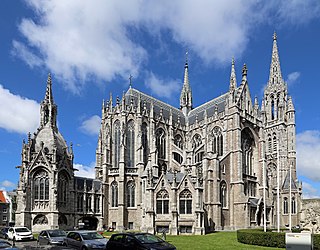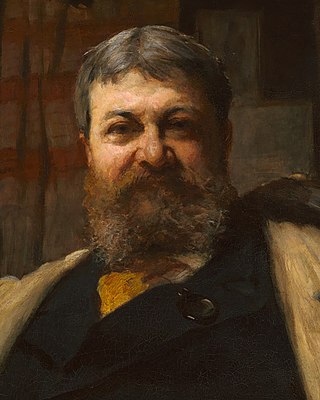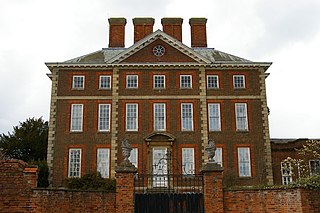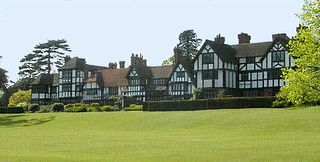
Ralph Adams Cram was a prolific and influential American architect of collegiate and ecclesiastical buildings, often in the Gothic Revival style. Cram & Ferguson and Cram, Goodhue & Ferguson are partnerships in which he worked. Cram was a fellow of the American Institute of Architects.

Gothic Revival is an architectural movement that began in the late 1740s in England. The movement gained momentum and expanded in the first half of the 19th century, as increasingly serious and learned admirers of the neo-Gothic styles sought to revive medieval Gothic architecture, intending to complement or even supersede the neoclassical styles prevalent at the time. Gothic Revival draws upon features of medieval examples, including decorative patterns, finials, lancet windows, and hood moulds. By the middle of the 19th century, Gothic had become the preeminent architectural style in the Western world, only to fall out of fashion in the 1880s and early 1890s.

The University of Oklahoma (OU) is a public research university in Norman, Oklahoma. Founded in 1890, it had existed in Oklahoma Territory near Indian Territory for 17 years before the two Territories became the state of Oklahoma. In Fall 2022, the university had 29,705 students enrolled, most at its main campus in Norman. Employing nearly 3,000 faculty members, the school offers 152 baccalaureate programs, 160 master's programs, 75 doctorate programs, and 20 majors at the first professional level.

Henry Hobson Richardson, FAIA was an American architect, best known for his work in a style that became known as Richardsonian Romanesque. Along with Louis Sullivan and Frank Lloyd Wright, Richardson is one of "the recognized trinity of American architecture".

The Queen Anne style of British architecture refers to either the English Baroque architecture of the time of Queen Anne or the British Queen Anne Revival form that became popular during the last quarter of the 19th century and the early decades of the 20th century. In other English-speaking parts of the world, New World Queen Anne Revival architecture embodies entirely different styles.

Collegiate Gothic is an architectural style subgenre of Gothic Revival architecture, popular in the late-19th and early-20th centuries for college and high school buildings in the United States and Canada, and to a certain extent Europe. A form of historicist architecture, it took its inspiration from English Tudor and Gothic buildings. It has returned in the 21st century in the form of prominent new buildings at schools and universities including Princeton and Yale.

Tudor Revival architecture first manifested itself in domestic architecture in the United Kingdom in the latter half of the 19th century. Based on revival of aspects that were perceived as Tudor architecture, in reality it usually took the style of English vernacular architecture of the Middle Ages that had survived into the Tudor period. The style later became an influence elsewhere, especially the British colonies. For example, in New Zealand, the architect Francis Petre adapted the style for the local climate. In Singapore, then a British colony, architects such as R. A. J. Bidwell pioneered what became known as the Black and White House. The earliest examples of the style originate with the works of such eminent architects as Norman Shaw and George Devey, in what at the time was considered Neo-Tudor design.

Bacone College, formerly Bacone Indian University, is a private tribal college in Muskogee, Oklahoma. Founded in 1880 as the Indian University by missionary Almon C. Bacone, it was originally affiliated with the mission arm of what is now American Baptist Churches USA. Renamed as Bacone College in the early 20th century, it is the oldest continuously operated institution of higher education in Oklahoma. The liberal arts college has had strong historic ties to several tribal nations, including the Muscogee and Cherokee. The Bacone College Historic District has been on the National Register of Historic Places listings in Muskogee County, Oklahoma since 2014.
William Bennett Bizzell was the president of three American higher education institutions. He was the fifth president of the University of Oklahoma, the president of Agricultural and Mechanical College of Texas, and the president of the College of Industrial Arts.

English Gothic is an architectural style that flourished from the late 12th until the mid-17th century. The style was most prominently used in the construction of cathedrals and churches. Gothic architecture's defining features are pointed arches, rib vaults, buttresses, and extensive use of stained glass. Combined, these features allowed the creation of buildings of unprecedented height and grandeur, filled with light from large stained glass windows. Important examples include Westminster Abbey, Canterbury Cathedral and Salisbury Cathedral. The Gothic style endured in England much longer than in Continental Europe.

El Reno High School is a set of school buildings in El Reno, Oklahoma.

The Bizzell Memorial Library, known also as Bizzell Library, is a five-story brick structure located at the University of Oklahoma in Norman, Oklahoma. It is an elaborate Collegiate Gothic or Cherokee Gothic building, designed by the architecture firm Layton Hicks & Forsyth and erected in 1928 during the administration of OU's fifth president, William Bennett Bizzell.

The Cherokee Female Seminary,, was built by the Cherokee Nation in 1889 near Tahlequah, Indian Territory. It replaced their original girls' seminary that had burned down on Easter Sunday two years before. It was listed on the National Register of Historic Places in 1973.
The Cherokee Male Seminary was a tribal college established in 1846 by the Cherokee Nation in Indian Territory. Opening in 1851, it was one of the first institutions of higher learning in the United States to be founded west of the Mississippi River.
The University of Arkansas Campus Historic District is a historic district that was listed on the National Register of Historic Places on September 23, 2009. The district covers the historic core of the University of Arkansas campus, including 25 buildings.
Layton & Forsyth was a prominent Oklahoma architectural firm that also practiced as partnership including Layton Hicks & Forsyth and Layton, Smith & Forsyth. Led by Oklahoma City architect Solomon Layton, partners included George Forsyth, S. Wemyss Smith, Jewell Hicks, and James W. Hawk.

The Great Hall is a grade II listed Gothic Revival building located at the University of Leeds in West Yorkshire, England. The building is primarily used for formal occasions such as graduation ceremonies and university students' examinations. Its undercroft was previously utilised to house the university library collections before the Brotherton Library opened in 1936. The Great Hall is one illustration of the many diverse styles of buildings on the campus of the University of Leeds; it is an example of red brick architecture associated with the term red brick university.

High Victorian Gothic was an eclectic architectural style and movement during the mid-late 19th century. It is seen by architectural historians as either a sub-style of the broader Gothic Revival style, or a separate style in its own right.
The history of college campuses in the United States begins in 1636 with the founding of Harvard College in Cambridge, Massachusetts, then known as New Towne. Early colonial colleges, which included not only Harvard, but also College of William & Mary, Yale University and The College of New Jersey, were modeled after equivalent English and Scottish institutions, but American establishments gradually split with their forebears, both physically and academically.














